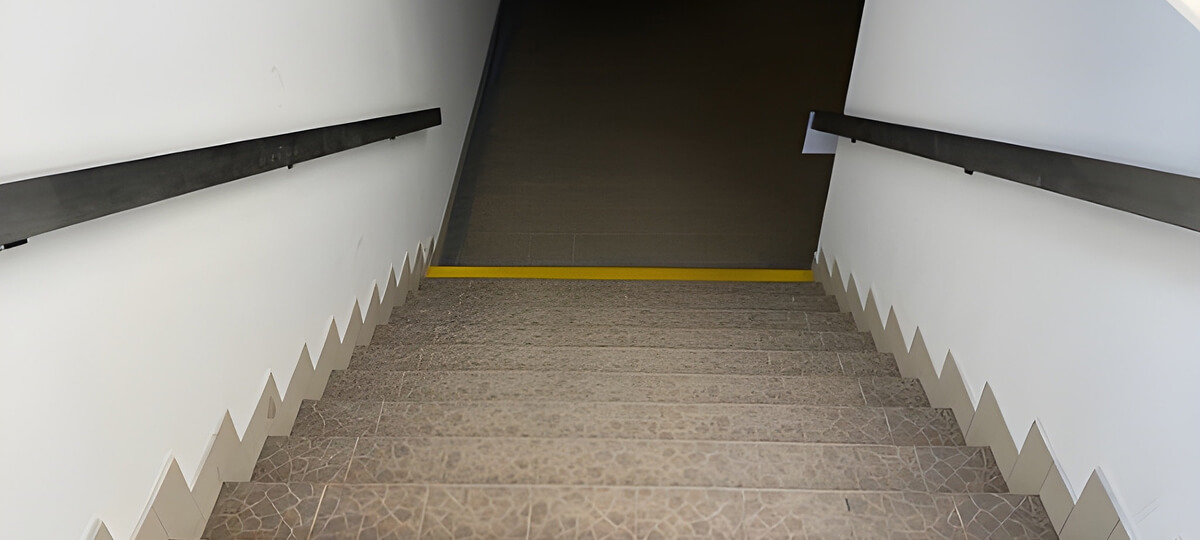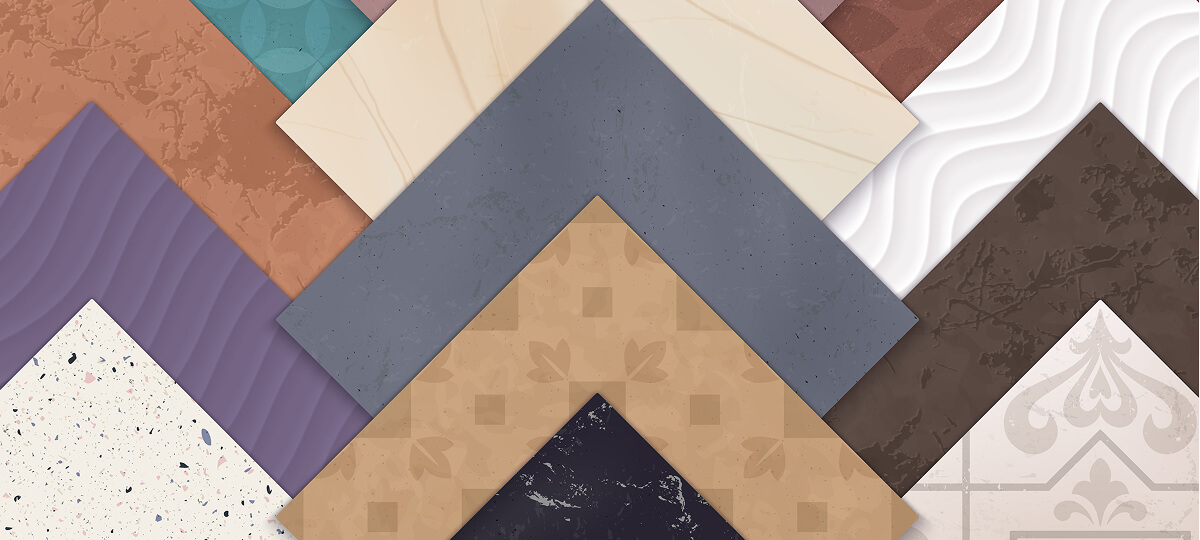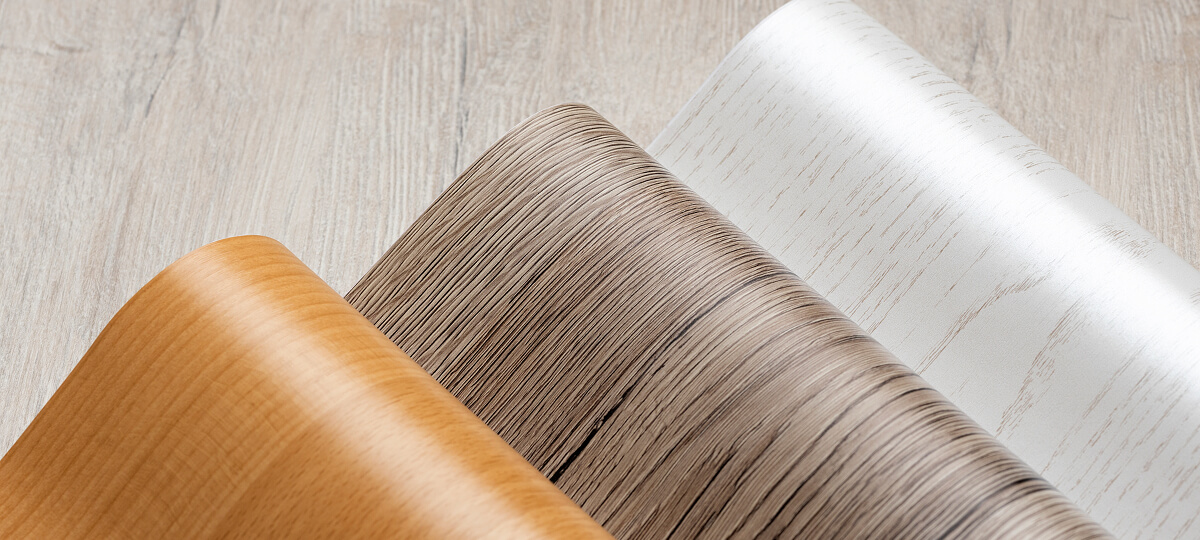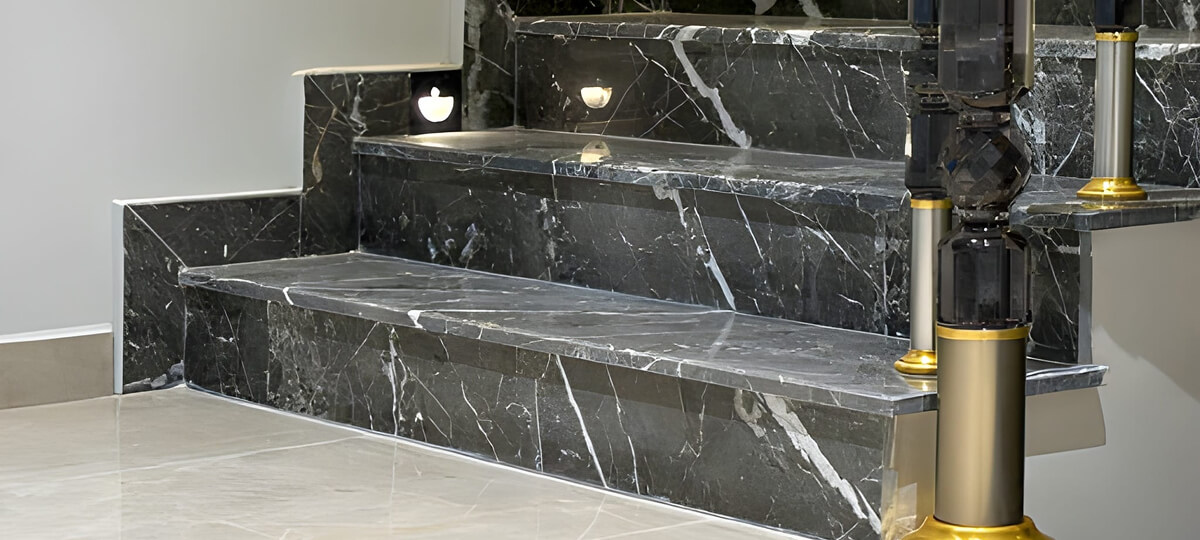Latest Porcelain and Ceramic Tile Trends for Your Restrooms
Though the restroom is the smallest room in our home, you cannot ignore its styl...
/ 03 November 2025
There’s something quietly elegant about a staircase that feels both sturdy underfoot and beautiful to look at. Yet, picking the right stair tiles isn’t just about matching your home’s decor; it’s about protecting everyone who walks those steps. The right tile should provide grip when needed, handle daily wear, and still make your hallway or foyer feel welcoming.
From slip ratings and textures to color choices and finishes, the options can get overwhelming fast. But don’t worry, this guide breaks down what really matters when choosing stair tiles for your home.
You’ll learn how to balance safety, durability, and design, so each step is both secure and stylish.
Most homeowners assume stair tiles are just floor tiles trimmed to fit the steps, but there’s more to it than meets the eye. Stair tiles are designed to handle unique pressures, angles, and risks that ordinary flooring doesn’t face. Each step has its own impact point, and without the right grip or edge profile, even a well-designed staircase can turn unsafe.
Regular floor tiles focus mainly on style and durability across flat surfaces. Stair tiles, on the other hand, are built to withstand higher foot pressure, reduce slipping hazards, and maintain visual consistency along vertical and horizontal planes. Their edges are often rounded or fitted with nosing to prevent sharp corners, while their surface textures are engineered to provide extra traction.
In short, a proper stair tile does three things: it grounds your footing, supports long-term durability, and keeps the entire staircase visually seamless. Choosing tiles made specifically for stairs isn’t just an aesthetic choice; it’s a safety investment that pays off every single day.

Safety should always be the first box you tick when choosing stair tiles. A sleek surface might look good in the showroom, but one wet step can turn beauty into a hazard. The goal is to find tiles that feel firm underfoot, even when damp, without sacrificing the overall look of your stairs.
Every tile has an R-rating that measures its level of slip resistance. The higher the number, the better the grip.
If you are tiling stairs near a kitchen, bathroom, or outdoor patio, aim for at least R11 to ensure steady footing.
Smooth, glossy tiles may shine under the light, but they are a slip waiting to happen. Choose matte, textured, or stone-finish tiles that offer natural grip. A slightly rough surface can make a big difference, especially for homes with kids or elderly residents.
Edges take a lot of wear and tear. Rounded or beveled edges reduce chipping and improve safety. You can also add anti-slip nosing strips or contrasting edge tiles to enhance visibility and prevent trips, which is particularly helpful in low-light staircases.
Large-format tiles can look elegant, but if not cut properly, they may create uneven steps. Opt for medium-sized tiles that fit comfortably across treads and risers without excessive cutting.
The safest stair tile design is one that feels balanced, firm, textured, and visually clear. When done right, your stairs can look inviting and still be one of the most secure spots in your home.
The material you choose for stair tiles is more than a matter of taste. It decides how the stairs will feel underfoot, how safe they’ll be during daily use, and how much care they’ll need over the years. Each option has its strengths and compromises, so it helps to match your tile choice with your lifestyle and the staircase location.

Porcelain tiles are known for their strength and water resistance, which makes them ideal for high-traffic staircases. They’re baked at higher temperatures than ceramic, resulting in a denser and harder finish that stands up to constant use. Porcelain can also mimic stone, wood, or concrete, giving you plenty of flexibility without sacrificing durability.
Best for: Indoor or outdoor stairs, homes with kids or pets, or humid climates.
Pros:
Cons:

Ceramic tiles share a similar appearance to porcelain but are a bit more porous and softer. They are a practical choice for homes where stairs don’t take heavy traffic, such as bedrooms or secondary staircases. Their wide color range makes them a designer’s favorite for customized looks.
Best for: Indoor staircases with moderate use, decorative or accent stairs.
Pros:
Cons:

If you want your staircase to make a statement, natural stone tiles such as marble, granite, or slate can do just that. Each stone carries its own texture, pattern, and tone, so no two installations ever look identical. However, stone demands regular sealing to protect it from stains and moisture.
Best for: Statement staircases, luxury interiors, or homes with natural finishes.
Pros:
Cons:

Vinyl and SPC tiles offer a practical solution for homeowners who want a blend of comfort, safety, and affordability. SPC, in particular, has a rigid core that provides stability and resistance to dents and moisture. These tiles often come with built-in texture, improving grip and making them safer for busy households.
Best for:Indoor staircases, rental homes, or homes seeking quick upgrades.
Pros:
Cons:
Sustainable materials are becoming increasingly popular as homeowners look for greener choices. Tiles made from recycled glass, reclaimed ceramics, or bamboo composites offer unique looks while reducing environmental impact. Some options even use low-emission glazes or recycled materials in production.
Best for:Environmentally conscious homeowners or modern, minimal interiors.
Pros:
Cons:
Quick Tip: If your stairs are outdoors, choose materials that can withstand rain, sunlight, and temperature changes. Porcelain or textured stone tiles work best for those conditions. For indoor use, ceramic or vinyl options may be more budget-friendly while still safe and attractive.

Designing a staircase is about more than picking tiles that look nice on display. The right stair tiles can completely shift the atmosphere of a home. They connect one floor to the next, catch light in quiet ways, and often become the first thing guests notice when they walk in.
When chosen thoughtfully, stair tiles add depth and warmth without trying too hard to stand out.
Start with what your home already says. If your floors are sleek and modern, continue that feeling with large porcelain tiles in soft neutral tones. They create a clean, flowing transition from one level to another. For a cozier home filled with wood or vintage touches, matte ceramic or wood-look tiles work beautifully. They bring texture and comfort while aging gracefully with everyday use.
Sometimes a touch of contrast feels right. Deep gray stair tiles can ground a light interior, while pale stone tiles brighten darker spaces. Think about how you want the stairs to feel beneath your feet and in your line of sight.
Color plays a role in safety as well as style. A gentle contrast between treads and risers helps define each step, making it easier to see in dim light. Try soft beige treads with white risers for a calm look or darker treads with lighter risers for a classic tone. Patterned riser tiles can add charm without overdoing it. A hint of mosaic or geometric print brings personality and makes even a small staircase feel designed, not accidental.
Glossy tiles may catch the light nicely, but they are risky on stairs. Choose matte, textured, or brushed finishes that provide grip and a more natural feel underfoot. They also do a better job of hiding dust and small scratches. If you still want a bit of shine, use glossy tiles on the risers and keep the steps matte. This balance looks refined while keeping the surface safe.
The pattern you choose affects how your staircase feels.
Grout color makes a surprising difference too. Matching grout blends everything together for a modern, seamless look, while a contrasting shade highlights the geometry of each tile.
Tiles and lighting go hand in hand. Textured tiles soften artificial light, while smooth ones reflect it. For darker staircases, warm lighting or subtle LED strips under each step create both comfort and safety.
The best stair tile designs don’t need to be dramatic. What matters is how they fit the home around them. When the right color, texture, and layout come together, the staircase feels natural, grounded, and quietly stylish.

Even the best tiles can fail if they’re installed poorly or neglected afterward. Staircases face constant pressure, temperature changes, and dirt buildup, so a careful installation and steady upkeep routine are what keep them safe and attractive for years.
Before any tile goes down, the surface beneath it needs to be even, dry, and strong. Small cracks or uneven layers can lead to loose tiles or hollow sounds later. For concrete stairs, a self-leveling compound helps create a flat surface. Wooden stairs may need a cement board layer for extra stability and to prevent moisture damage. A small uneven spot might not look serious at first, but on stairs, even a few millimeters can throw off alignment and create trip points.
Stairs experience more movement and impact than floors, so adhesive choice matters. Go for flexible, high-bond thinset mortar designed for stairs or vertical applications. It holds tight even when the structure shifts slightly with temperature or pressure changes. Spread the adhesive evenly using a notched trowel, and press each tile firmly into place. Double-check alignment at every step. A single misplaced tile can ruin the rhythm of the whole staircase.
Grouting is not just about filling gaps. It adds strength, helps resist moisture, and keeps tiles from shifting. Use grout that matches the tile’s durability level—epoxy grout works best for high-traffic stairs. Once the grout is dry, apply a sealer to make cleaning easier and reduce stains. A light resealing once or twice a year keeps your stairs looking new and helps maintain traction.
Edges are the first place to wear shows. Rounded or bullnose tiles soften the look and protect corners from chipping. For added safety, install metal or rubber nosing strips. They improve grip and add definition to each step, which helps prevent slips in dim lighting. If you prefer a continuous look, you can use grooved tile nosing instead of separate strips. It keeps the design unified while still adding traction.
A simple cleaning routine keeps stair tiles safe and fresh. Sweep or vacuum regularly to remove dust and grit that could cause scratches. For deeper cleaning, use a pH-neutral tile cleaner and a damp mop. Avoid wax or oil-based products, which can make tiles slippery. If your stairs get heavy traffic, consider adding anti-slip treatments or transparent coatings every year or two. They renew the surface grip without changing the tile’s look.
Even with care, small chips or cracks may appear over time. Repair them quickly to prevent further damage. Keep a few spare tiles from your original batch for replacements, as patterns and shades can change slightly over time. Every few years, inspect your stairs for loosened grout, shifting tiles, or fading finishes. A little maintenance now saves a full replacement later.
Proper installation and aftercare turn your tiled staircase from a design choice into a lasting feature. When the surface stays firm, clean, and safe, every step feels just as solid as the day it was built.
Choosing the right stair tiles might seem tricky. However, the steps mentioned above can make the installation game easy for you. After all, consider some crucial factors such as how much traffic your stairs should handle, where the stair is located, how much rain or water your stairs have to deal with, etc. If you're stuck to designing on your own, contact our expert team today. Our team will inspect your location in person and provide you with expert advice on choosing the right tiles for your stairs.
Porcelain tiles with a matte or textured finish are generally the safest. They provide strong grip, resist moisture, and handle wear well. If you have children or older family members at home, look for tiles rated R11 or higher for slip resistance.
Yes, as long as the tiles are designed for flooring and have a suitable slip rating. Many homeowners use the same tile on floors and stairs for a seamless look. However, you may want to use a more textured version of the same tile on the stairs to improve safety.
Glossy tiles can be risky, especially on stairs that might get wet or dusty. They look beautiful but become slippery easily. If you love the glossy look, limit it to the risers or walls beside the stairs and keep the treads matte or textured.
For outdoor stairs, go with porcelain or textured natural stone. Both can handle temperature changes, moisture, and sunlight. Avoid polished stone or smooth ceramic because they become slick when wet.
Regular cleaning and reapplying anti-slip coatings make a big difference. Also, keep an eye on dirt buildup, as dust and grime can reduce traction. Using mats at entry points helps cut down on tracked-in moisture.
They can if installed over an uneven surface or with poor adhesive. Choose a high-quality flexible mortar and make sure the base is level before installation. Proper grouting and sealing also prevent small cracks from spreading.
Sweep or vacuum at least once a week to remove grit. Use a mild, pH-neutral cleaner when mopping. For stone or sealed tiles, reseal once a year to preserve shine and traction.
If you have experience with tiling flat floors, stair installation might still surprise you. The precision needed for alignment and edge finishing is higher. It’s best to handle small projects yourself and call a professional for full staircases.
Though the restroom is the smallest room in our home, you cannot ignore its styl...
Are you looking for the most attractive wall tiles design in Bangladesh at the b...
Looking for high-quality kitchen tiles design in Bangladesh? DBL Ceramics is off...
There is something exceptional about having a gorgeous bathroom. Imagine enter...
Not all tiles are suitable for the shower room. Due to water spills, this area t...
Are you looking for the best floor tiles design in Bangladesh? Following a ...
Whether having a family meal or fun with your friends, the dining room is certai...
DBL Ceramics, one of Bangladesh's leading ceramic tile dealers, takes pride in o...
Tiles may not always be the main attraction of home, but their influence is unde...
Do you want your living room to look more aesthetic than others? If so, you shou...
As the saying goes, "You can get to someone's heart through their stomach," but ...
Nowadays, rustic tiles are very captivating because they can bring back the good...
Kitchen tiles have been transformed from basic, practical surfaces into fashiona...
Tired of seeing those boring old bathroom tiles every morning? You're not alone!...
Thinking about using wooden tiles in your home instead of the usual choices? The...
Picking the right floor tiles texture can change the entire feel of a Bangladesh...